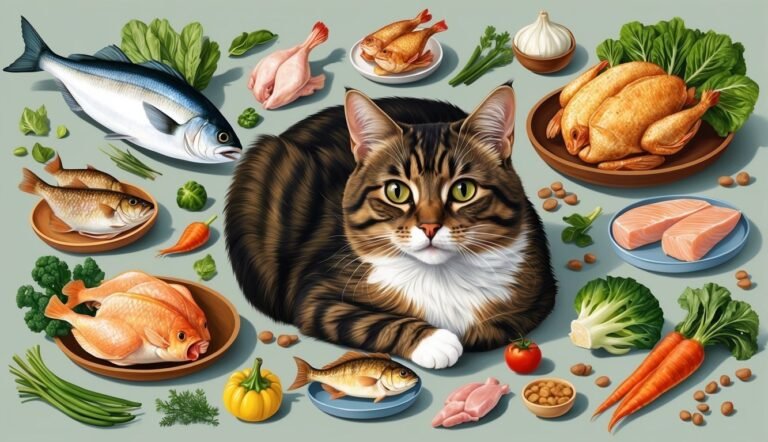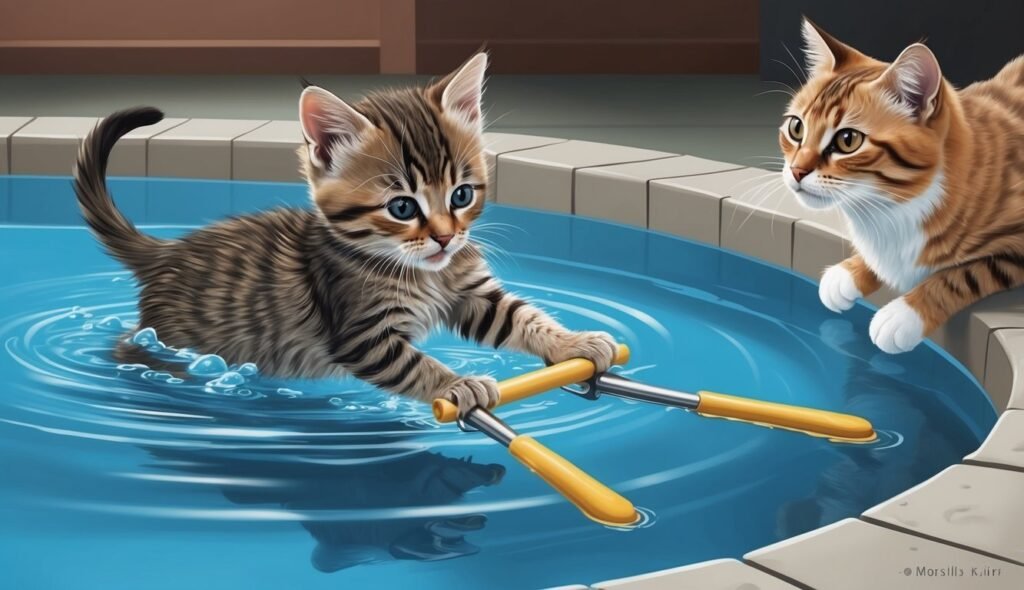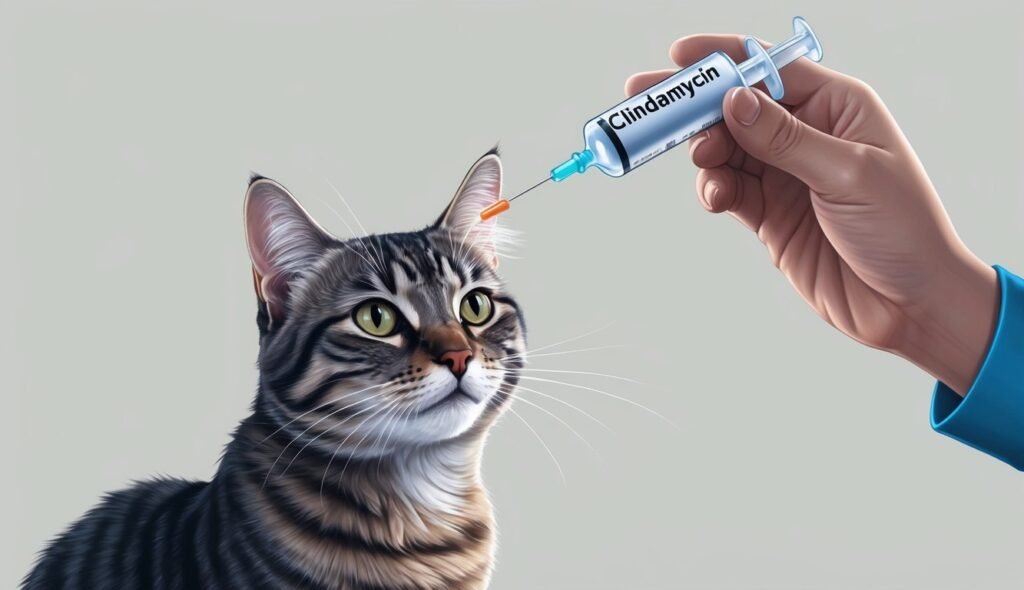Cats thrive on natural foods that align with their instinctual dietary habits.
Feeding your cat a natural diet can improve their health, strengthen their immune system, and enhance their overall quality of life.
Understanding what constitutes a natural diet for your feline can help you make informed choices that suit their needs and preferences.
You can explore various types of natural cat food, from high-quality commercial options to homemade recipes.
Each choice offers unique benefits, addressing specific dietary requirements and promoting better digestion.
With so many available options, it’s essential to recognize which foods are safe and appropriate for your pet.
Transitioning your cat to a natural diet may seem daunting, but it can be a rewarding experience for both you and your furry companion.
By prioritizing their nutritional requirements, you can foster a healthy and happy lifestyle that reflects your cat’s natural instincts.
Key Takeaways
- Natural diets can significantly benefit your cat’s health.
- Understanding food labels helps you choose the right products.
- Homemade meals offer a fresh and nutritious alternative for your cat.
The Natural Diet of Cats
Cats thrive on a diet that mirrors their natural instincts and biological needs.
Understanding their dietary requirements as obligate carnivores can help you choose the best food options for your feline friend.
Understanding Obligate Carnivores
As obligate carnivores, your cat’s body is built specifically to process animal protein.
Unlike humans or dogs, cats have a unique digestive system that requires a diet predominantly made up of animal-based nutrition.
This means they need a higher intake of protein and certain nutrients that are primarily available through meat.
For example, cats cannot synthesize taurine, an essential amino acid found in animal tissues.
A diet lacking in animal protein can lead to serious health issues, so prioritizing high-quality meat sources is crucial.
Essential Nutrients in a Cat’s Diet
Alongside protein, your cat’s diet needs to include various essential nutrients for optimal health.
Here’s a quick overview of some key components:
- Animal Protein: This should make up the majority of your cat’s diet. Look for ingredients like chicken, turkey, or fish.
- Fats: Essential fatty acids, particularly Omega-3 and Omega-6, help maintain skin and coat health. These are often found in fish oil or animal fats.
- Vitamins and Minerals: Vitamins A, D, E, and K, along with minerals like calcium and phosphorus, support various bodily functions.
Make sure you choose cat food that lists animal protein as the first ingredient to ensure your cat gets all the nutrients it needs.
Types of Natural Cat Food
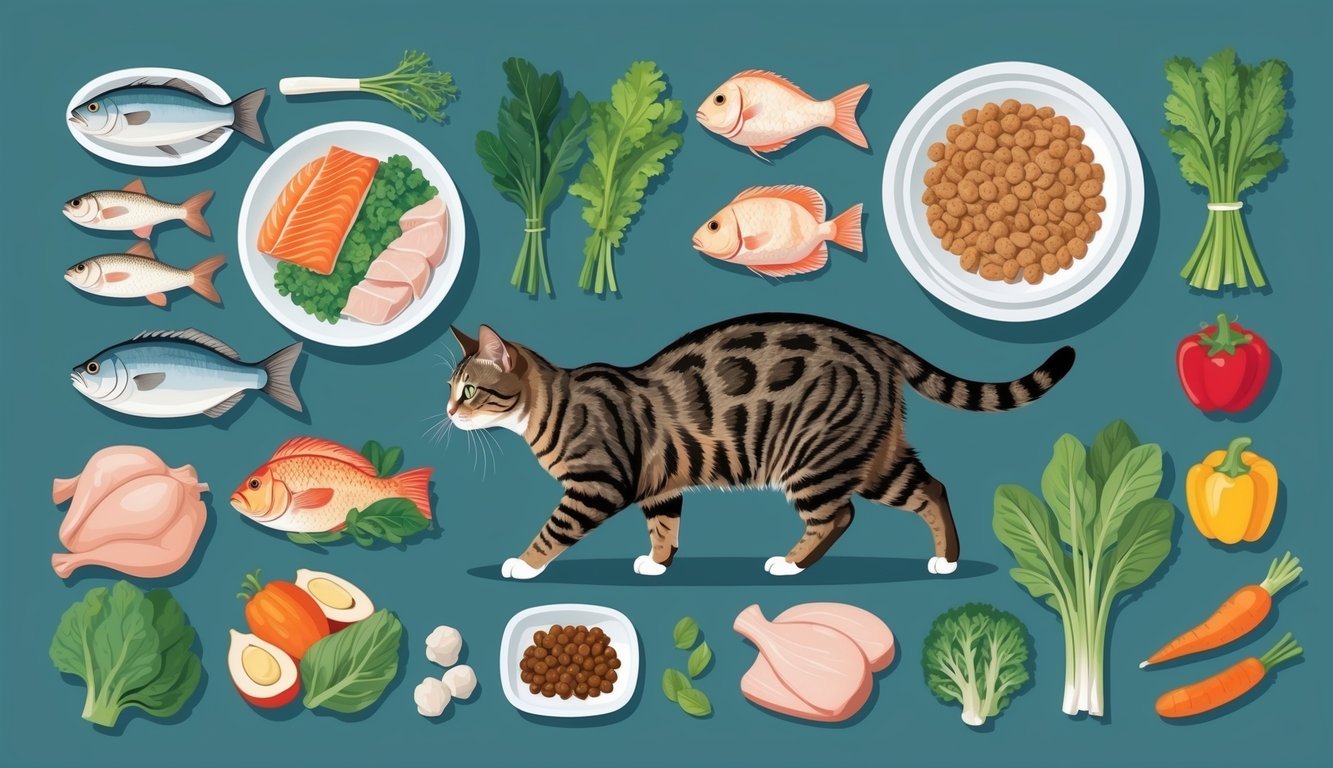
When selecting natural cat food, it’s essential to explore different types that cater to your feline’s needs.
The options range from wet food to grain-free formulations, each having unique advantages.
You’ll also want to consider the benefits of organic ingredients in these diets.
Benefits of Wet Natural Cat Food
Wet cat food offers numerous benefits you might consider for your pet.
One primary advantage is hydration.
Cats often do not drink enough water, and wet food can help boost their fluid intake.
Additionally, the high protein content in many wet foods mimics a cat’s natural diet.
These formulas usually include real meat as the primary ingredient, which supports muscle health.
Many wet foods, such as those from trusted brands, also have added vitamins and minerals, making them nutritionally complete.
They often appeal to picky eaters because of their strong aroma and palatability.
Exploring Grain-Free Options
Grain-free cat food is gaining popularity among pet owners.
Many cats are sensitive to grains, and grain-free formulas eliminate potential allergens, focusing instead on protein sources.
These foods typically have higher meat content, which aligns with a cat’s evolutionary diet.
Ingredients like lentils and peas often replace grains, providing fiber while keeping the carbohydrate count low.
Brands like Farmina produce grain-free options that ensure your cat gets the necessary nutrients without unwanted fillers.
This style of feeding can support better digestion and energy levels in your feline friend.
The Role of Organic Ingredients
Choosing cat food with organic ingredients can enhance the quality of your pet’s diet.
Organic foods often contain no synthetic additives, growth hormones, or antibiotics, making them a healthier alternative.
For instance, organic proteins like chicken or turkey can provide essential amino acids while ensuring ethical sourcing.
Products like Rachael Ray Nutrish promote real meat and organic vegetables, making them a solid choice for discerning cat owners.
Opting for the best organic cat food means focusing on brands that prioritize quality ingredients.
These typically aim for high nutritional standards, which may improve your pet’s overall health and well-being.
Choosing the Best Cat Food
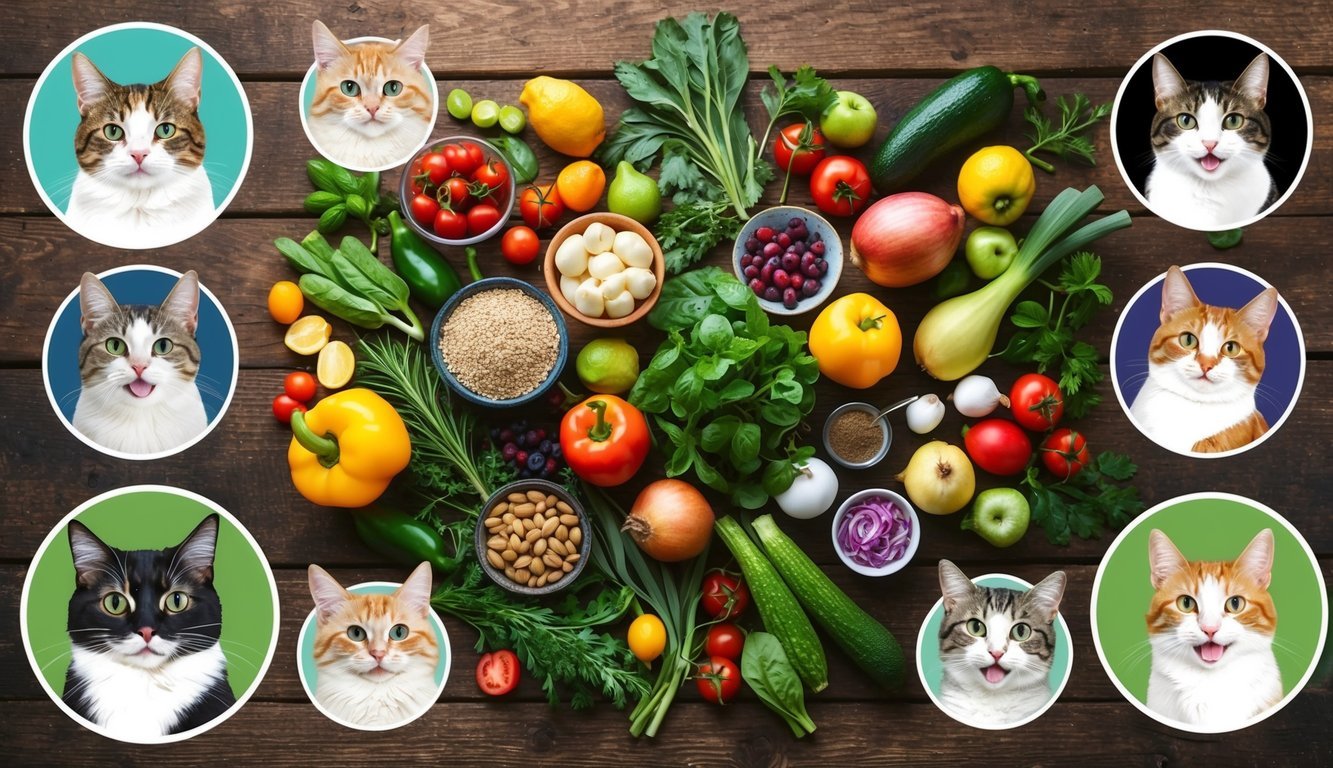
When selecting the right cat food, pay close attention to the ingredient list, the quality of the ingredients, and potential harmful additives.
These factors play a significant role in ensuring your cat’s health and well-being.
Deciphering the Ingredient List
Start by examining the ingredient list on the cat food package.
Look for meat sources at the top of the list, as cats are obligate carnivores.
A high-quality cat food should list specific proteins, such as chicken, turkey, or fish, rather than vague terms like “meat by-products.”
Next, check for the presence of carbohydrates.
Ideally, the food should have low carbohydrate content, as cats can struggle to process them.
The best natural cat food tends to feature whole food ingredients, including vegetables and fruits, as additional nutrients.
A clear ingredient list helps you avoid unknown fillers and makes it easier to assess nutritional quality.
Identifying Minimally Processed Ingredients
Choose cat foods that utilize minimally processed ingredients.
These foods retain more nutrients compared to heavily processed options, which can lose their nutritional value during manufacturing.
Look for phrases like “cold-pressed,” “air-dried,” or “fresh” on the packaging.
Consider brands that prioritize high-quality, whole food sources.
Ingredients such as chicken meal, salmon, or sweet potatoes deliver essential nutrients without extra fillers.
Inspect the nutritional profile and ensure it aligns with veterinary recommendations for your cat’s age and health needs.
Avoiding Harmful Additives and Allergens
Be vigilant about harmful additives and potential allergens.
Some common additives can include artificial flavors, colors, and preservatives like BHA or BHT, which may negatively impact your cat’s health.
Identify any ingredients your cat may be allergic to, such as soy, wheat, or corn, and avoid those.
If you’re unsure about specific allergens, choose a food labeled as “grain-free” or “limited ingredient.” These options often reduce the risk of allergic reactions and may help with digestive issues.
Always consult with your veterinarian if you suspect an allergy or have concerns about certain ingredients.
Health Benefits of Natural Feeding
Feeding your cat natural food can lead to several health improvements.
You’ll find that your feline friend may experience better digestive health and an enhanced sense of well-being.
These benefits stem from a diet rich in essential nutrients.
Promoting Digestive Health with Probiotics
Probiotics play a significant role in your cat’s digestive health.
These beneficial bacteria help maintain a balanced gut microbiome, which is essential for proper digestion.
A diet that includes natural ingredients often contains added probiotics, promoting healthy gut flora.
Here are some ways probiotics can help:
- Improved Digestion: They aid in breaking down food, making it easier for your cat to absorb nutrients.
- Reduction of Gastrointestinal Issues: Probiotics can alleviate symptoms like diarrhea or constipation, common in cats.
Incorporating natural foods high in fiber can also assist with digestion.
Ingredients like pumpkin and sweet potatoes are great supplements.
Enhancing Well-Being through Balanced Nutrition
Natural cat food is often formulated with a balance of high-quality proteins and healthy fats, such as omega-3 and omega-6 fatty acids.
These nutrients are essential for your cat’s overall health.
Healthy fats contribute to:
- Skin and Coat Health: Omega-3s and omega-6s support oil production in the skin, enhancing coat shine and softness.
- Anti-Inflammatory Properties: These fatty acids can help reduce inflammation, which benefits cats with joint issues or skin allergies.
By choosing high-quality, natural foods, you’re providing your cat with the right nutrients that support not just a healthy body but also a happy mood.
Nutritional balance leads to improved energy levels, making daily playtime more enjoyable.
Understanding Food Labels and Certifications
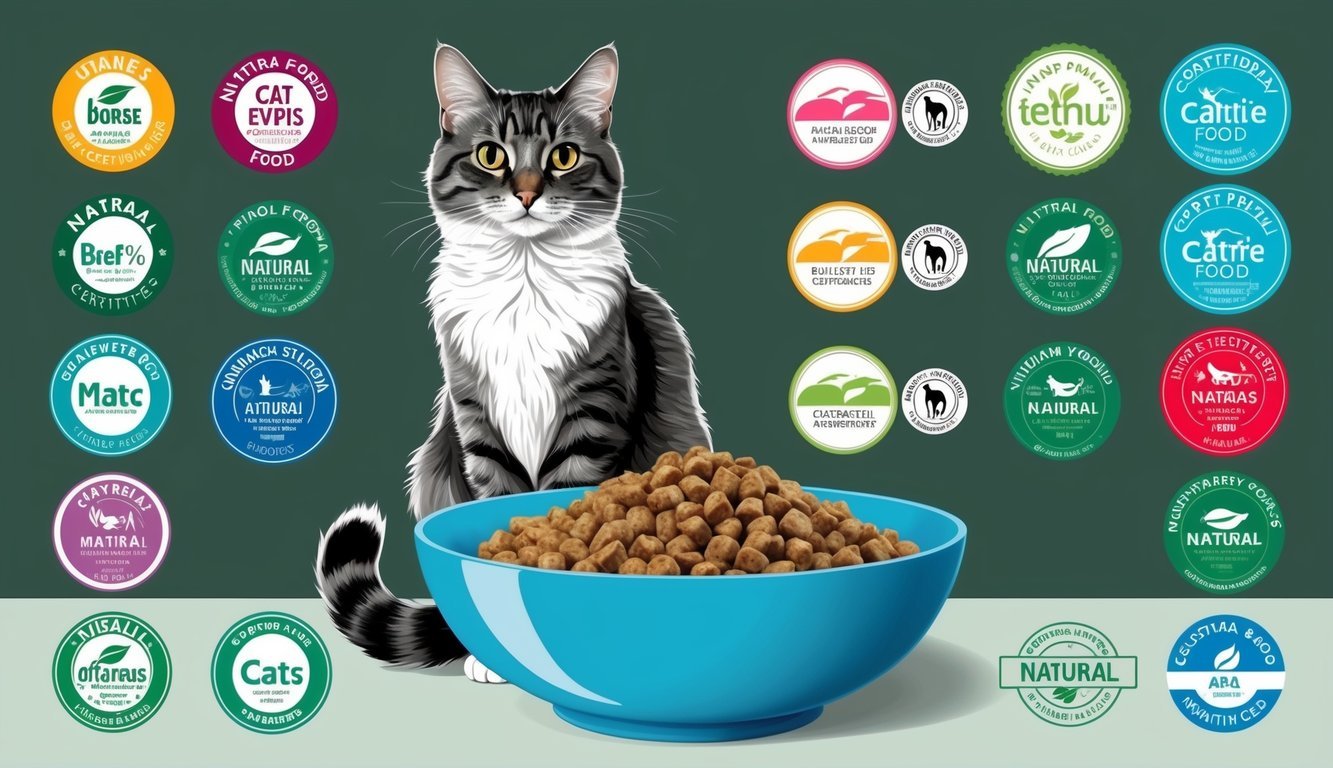
When selecting natural food for your cat, understanding labels and certifications is essential.
This knowledge helps you make informed decisions about the quality and suitability of the food you choose.
Paying attention to specific terms like “holistic” and “organic” can reveal a lot about the product’s ingredients and nutritional value.
What Does ‘Holistic’ Really Mean?
The term “holistic” on cat food labels suggests a focus on overall well-being, emphasizing natural ingredients.
However, it’s important to research brands that use this label carefully.
For example, Halo Holistic emphasizes whole food ingredients and avoids fillers.
Brands like Solid Gold also promote holistic practices, combining proper nutrition with health benefits.
When you see “holistic,” look for high-quality protein sources and whole grains.
Check the ingredient list to ensure it’s not just marketing fluff.
A truly holistic cat food should contain real meat, fruits, and vegetables without artificial additives.
Interpreting ‘Best Organic’ Claims
Organic cat food must meet specific standards set by regulatory agencies.
For a food to be labeled organic, the ingredients should be grown without synthetic fertilizers, pesticides, or GMOs.
Look for the USDA Organic seal as a clear indicator of quality.
The best organic cat foods prioritize high-quality meat sources, like chicken or fish, and include organic grains.
While browsing, pay attention to terms like “made with organic ingredients.” This phrase may imply that not all components are organic but still meet some organic standards.
Always read the ingredient list to confirm the actual organic content and assess its overall nutrition profile.
Special Diets for Sensitive Cats
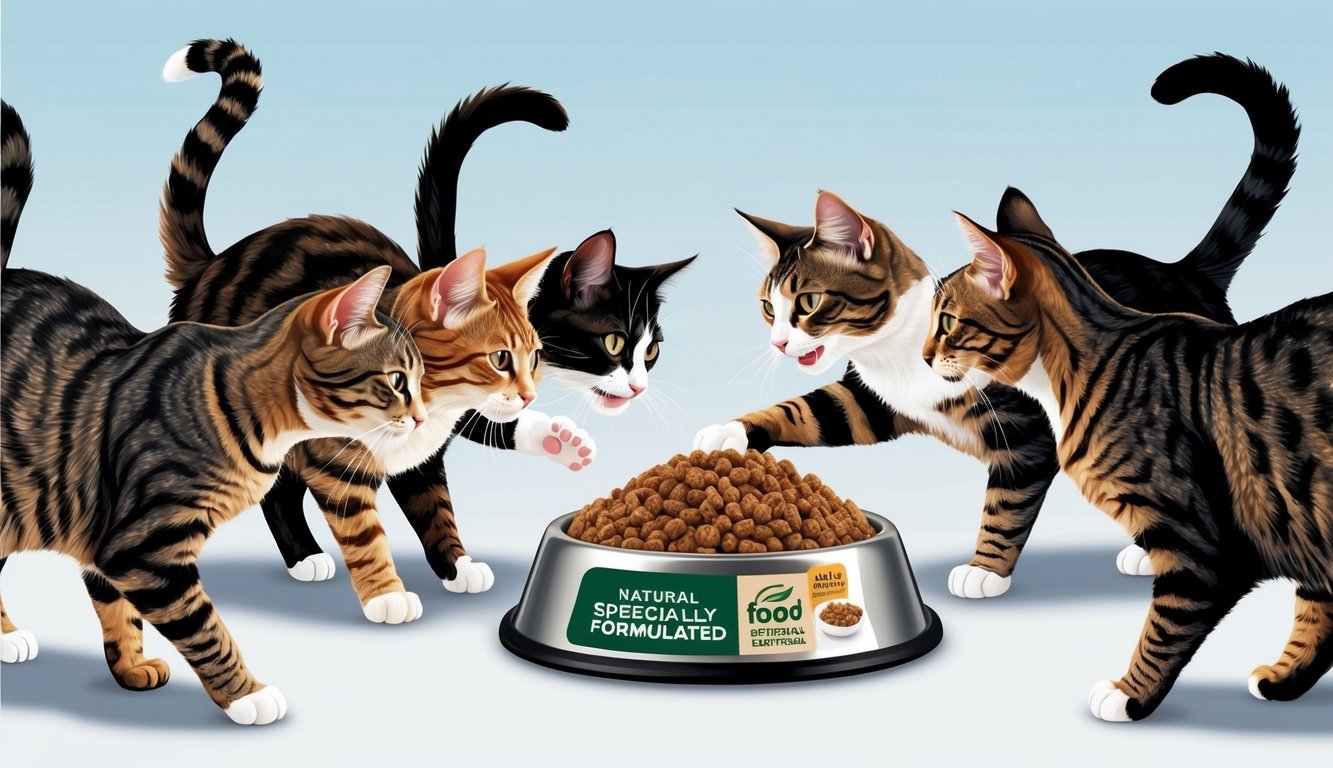
If your cat has a sensitive stomach, choosing the right food is crucial.
Special diets tailored for sensitive cats can help alleviate discomfort and promote better health.
Two effective options include limited ingredient recipes and understanding how to recognize food sensitivities.
Limited Ingredient Recipes
Limited ingredient recipes are designed specifically for cats with food sensitivities.
These diets often contain a single protein source and minimal ingredients, reducing the chances of triggering an allergic reaction.
Look for products that list quality proteins like turkey, chicken, or fish as the primary ingredient.
When browsing labels, identify potential allergens that your cat may react to.
Ingredients like corn, soy, and artificial additives are best avoided.
A few popular brands known for their limited ingredient formulas include:
- Royal Canin: Known for their veterinary diets.
- Hill’s Prescription Diet: Offers tailored solutions for food sensitivities.
- Blue Buffalo: Provides grain-free options.
Recognizing and Managing Food Sensitivities
It’s essential to be vigilant about your cat’s diet and any changes in their behavior.
Watch for signs such as vomiting, diarrhea, or excessive gas after meals.
Keeping a food diary can be helpful in tracking which foods may be causing issues.
If you suspect your cat has food sensitivities, consult with your veterinarian.
They may recommend an elimination diet, where you gradually introduce new foods while monitoring your cat’s reactions.
This can help pinpoint specific allergens.
Consider transitioning to a new diet gradually to avoid further stomach upset.
Mix small amounts of the new food with the old food over several days.
This gentle approach helps your cat adjust better to the new diet.
DIY Natural Cat Food
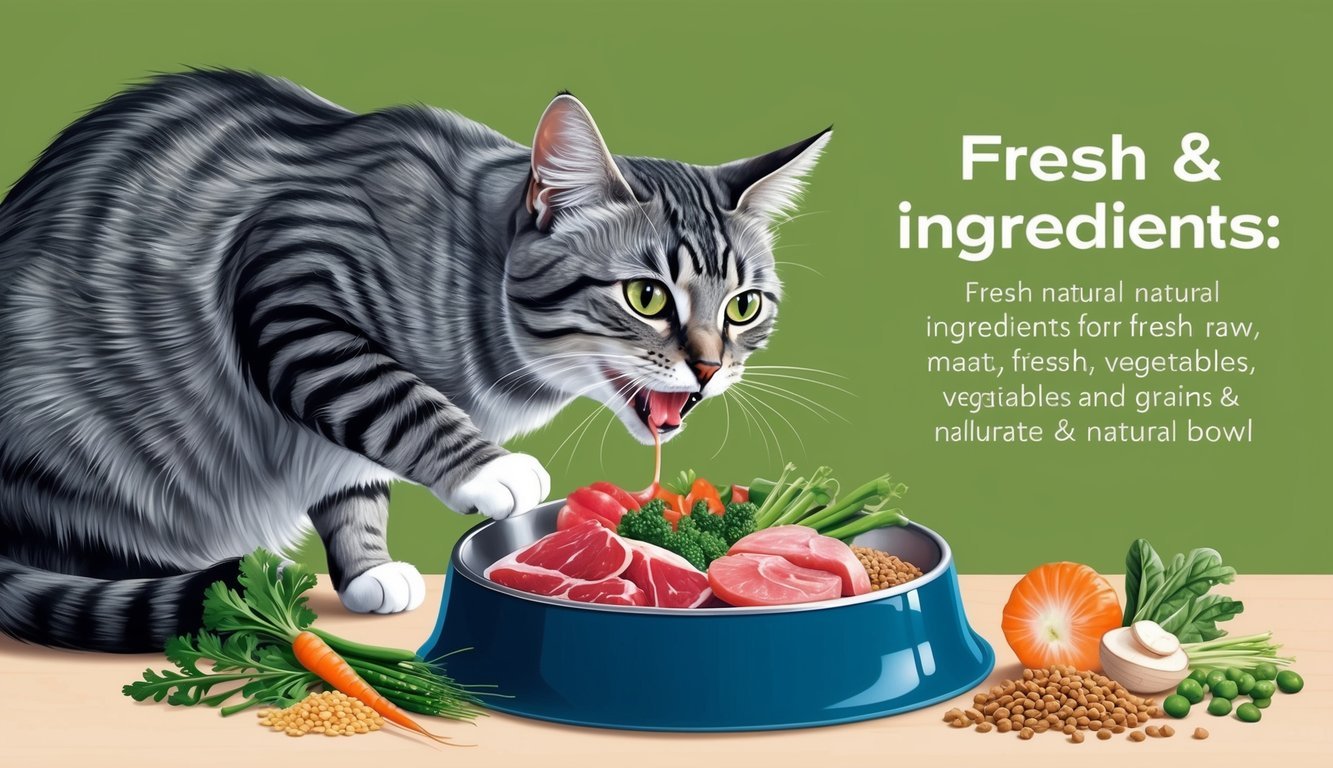
Preparing homemade natural cat food allows you to control the ingredients and ensure your cat gets the best nutrition.
This section explores simple recipes and safe human foods you can incorporate into your cat’s diet.
Homemade Cat Food Recipes
Creating your own cat food can be straightforward with a few ingredients and a bit of preparation.
Here are a couple of simple recipes:
Turkey and Sweet Potato Bowl
- 1 cup of cooked turkey (shredded)
- ½ cup of cooked sweet potato (mashed)
- ¼ cup of peas (cooked)
Mix all the ingredients in a bowl.
Serve at room temperature for your cat’s enjoyment.
Chicken and Broccoli Mix
- 1 cup of cooked chicken (shredded or diced)
- ¼ cup of steamed broccoli (mashed)
- ¼ cup of chicken broth (no salt)
Combine the chicken and broccoli in a food processor.
Add broth to achieve a desired consistency.
Make sure to introduce new foods gradually to monitor for any adverse reactions.
Human Foods Cats Can Safely Eat
Certain human foods are safe and beneficial for your feline friend.
Here’s a list to guide you:
- Cooked Fish: Like salmon or tuna; avoid raw fish.
- Plain Cooked Chicken: Bond with your cat by sharing small pieces.
- Eggs: Scrambled eggs can be a great treat; just ensure they are cooked thoroughly.
- Certain Vegetables: Cooked carrots, peas, and green beans are safe options.
Always remember to keep portions small.
Avoid seasoning and consult your vet before adding new foods to ensure they fit your cat’s dietary needs.
Choosing the Right Cat Food Brand

Selecting the right natural cat food brand is crucial for your feline friend’s health.
With so many options available, understanding the differences between brands can help you make an informed choice.
Comparing Top Natural Cat Food Brands
When looking at natural cat food brands, focus on those known for high-quality ingredients.
Brands like Hill’s Science Diet, Blue Buffalo, and Wellness are popular choices.
Consider the following when comparing:
-
Ingredient Quality: Look for real meat as the first ingredient. This indicates a higher protein content without unnecessary fillers.
-
Nutritional Balance: Check for essential nutrients. AAFCO standards require vitamins A, B12, D, E, and K, along with amino acids.
-
Additives: Be mindful of artificial additives. Brands that use natural preservatives, like mixed tocopherols, are preferable.
Trustworthy Labels and Quality Standards
Quality labeling can guide you toward the best options.
Look for brands that adhere to stringent quality control measures.
You should pay attention to:
-
AAFCO Approval: Brands that meet AAFCO standards ensure their food is nutritionally adequate.
-
Transparency: Trustworthy brands will provide clear ingredient sourcing on labels. This helps you know what you’re feeding your cat.
-
Recalls and Safety Records: Research a brand’s history for recalls. Consistent safety practices indicate higher reliability.
Frequently Asked Questions
There are many considerations when it comes to feeding your cat natural foods.
Here are some common questions that can help guide you in making the best choices.
What types of fresh foods can I safely give to my cat?
You can offer a variety of fresh foods, including cooked meats like chicken and turkey without seasoning.
Fish such as salmon can be given in moderation.
Some vegetables like steamed carrots and peas are also safe, but ensure they are chopped into small pieces.
What’s the best recipe for a homemade cat meal?
A simple recipe includes boiled chicken mixed with cooked rice and a small amount of carrots.
Make sure to shred the chicken and chop the veggies finely.
Always consult with a vet for balanced meal suggestions tailored to your cat’s specific needs.
Are there any natural foods that cats typically enjoy?
Cats often enjoy natural protein sources like poultry and fish.
Other options can include certain fruits such as blueberries or melon, but these should be offered sparingly due to sugar content.
Monitor your cat’s response to new foods closely.
What common fridge items are safe for cat consumption?
Safe items often include plain cooked eggs, small amounts of low-fat yogurt, or meat scraps without additives.
Avoid dairy and processed foods as they may upset your cat’s stomach.
Always check with your vet if unsure about a specific item.
How can I make a budget-friendly cat meal at home?
To create budget-friendly meals, consider using inexpensive protein sources like canned tuna or boiled eggs.
Pair these with grains like rice or oats and add some chopped vegetables.
Buying in bulk can also help save money.
Can you recommend some natural diet options for cats?
Natural diet options include high-quality commercial cat foods that use real meat as the primary ingredient.
You can also explore raw feeding if you’re comfortable with it.
Always ensure any diet is well-balanced and suitable for your cat’s age and health needs.

